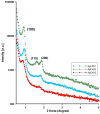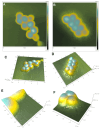Nanosilver-Biopolymer-Silica Composites: Preparation, and Structural and Adsorption Analysis with Evaluation of Antimicrobial Properties
- PMID: 39769310
- PMCID: PMC11679571
- DOI: 10.3390/ijms252413548
Nanosilver-Biopolymer-Silica Composites: Preparation, and Structural and Adsorption Analysis with Evaluation of Antimicrobial Properties
Abstract
In this article, we report on the research on the synthesis of composites based on a porous, highly ordered silica material modified by a metallic nanophase and chitosan biofilm. Due to the ordered pore system of the SBA-15 silica, this material proved to be a good carrier for both the biologically active nanophase (highly dispersed silver nanoparticles, AgNPs) and the adsorption active phase (chitosan). The antimicrobial susceptibility was determined against Gram-positive Staphylococcus aureus ATCC 25923, Gram-negative bacterial strains (Escherichia coli ATCC 25922, Klebsiella pneumoniae ATCC 700603, and Pseudomonas aeruginosa ATCC 27853), and yeast Candida albicans ATCC 90028. The zones of microbial growth inhibition correlated with the content of silver nanoparticles deposited in the composites and were the largest for C. albicans (14-21 mm) and S. aureus (12-17 mm). The suitability of the composites for the purification of water and wastewater from anionic pollutants was evaluated based on kinetic and equilibrium adsorption studies for the dye Acid Red 88. The composite with the highest amount of the chitosan component showed the greatest adsorption capacity (am) of 0.57 mmol/g and the most effective kinetics with a rate constant (log k) and half-time (t0.5) of -0.21 and 1.62 min, respectively. Due to their great practical importance, AgNP-chitosan-silica composites can aspire to be classified as functional materials combining the environmental problem with microbiological activity.
Keywords: adsorption equilibrium; adsorption kinetics; biopolymer; chitosan; dye adsorption; nanosilver–chitosan–silica composite; silica.
Conflict of interest statement
The authors declare no conflicts of interest.
Figures




















Similar articles
-
Synthesis of biopolymer blends nanocomposites embedded with mono-(Ag, Fe) and bi-(Ag-Fe) metallic nanoparticles using an eco-friendly approach for antimicrobial activities.Bioprocess Biosyst Eng. 2024 Aug;47(8):1293-1306. doi: 10.1007/s00449-024-03011-6. Epub 2024 Apr 3. Bioprocess Biosyst Eng. 2024. PMID: 38568262
-
Synthesis of Ag@Fe2O3 nanocomposite based on O-carboxymethylchitosan with antimicrobial activity.Int J Biol Macromol. 2018 Feb;107(Pt A):42-51. doi: 10.1016/j.ijbiomac.2017.08.147. Epub 2017 Sep 21. Int J Biol Macromol. 2018. PMID: 28870753
-
Silver Nanoparticles on Chitosan/Silica Nanofibers: Characterization and Antibacterial Activity.Int J Mol Sci. 2019 Dec 25;21(1):166. doi: 10.3390/ijms21010166. Int J Mol Sci. 2019. PMID: 31881739 Free PMC article.
-
Chitosan-Silica Composites for Adsorption Application in the Treatment of Water and Wastewater from Anionic Dyes.Int J Mol Sci. 2023 Jul 23;24(14):11818. doi: 10.3390/ijms241411818. Int J Mol Sci. 2023. PMID: 37511577 Free PMC article.
-
Silver Nanoparticles Prepared Using Magnolia officinalis Are an Effective Antimicrobial Agent on Candida albicans, Escherichia coli, and Staphylococcus aureus.Probiotics Antimicrob Proteins. 2025 Apr;17(2):625-639. doi: 10.1007/s12602-023-10179-y. Epub 2023 Oct 16. Probiotics Antimicrob Proteins. 2025. PMID: 37843750
References
-
- Sherafati Chaleshtori A., Marzhoseyni Z., Saeedi N., Azar Bahadori R., Mollazadeh S., Pourghadamyari H., Sajadimoghadam E., Abbaszadeh-Goudarzi K., Moradi Hasan-Abad A., Sharafati Chaleshtori R. Gelatin-based nanoparticles and antibiotics: A new therapeutic approach for osteomyelitis? Front. Mol. Biosci. 2024;11:1412325. doi: 10.3389/fmolb.2024.1412325. - DOI - PMC - PubMed
-
- Karachkovska A.D., Syrvatka V.J., Gromyko O.M., Fedorenko V.O. Nanoengineering: Fabrication, Properties, Optics, Thin Films, and Devices XVII. Volume 1146721 SPIE; Bellingham, WA, USA: 2020. Synthesis of antibiotic-silver nanoparticles complexes, their properties, and application for investigation of antibiotic-resistance mechanisms.
-
- Khurana C., Sharma P., Pandey O.P., Chudasama B. Synergistic Effect of Metal Nanoparticles on the Antimicrobial Activities of Antibiotics against Biorecycling Microbes. J. Mater. Sci. Technol. 2016;32:524–532. doi: 10.1016/j.jmst.2016.02.004. - DOI
MeSH terms
Substances
LinkOut - more resources
Full Text Sources
Molecular Biology Databases

